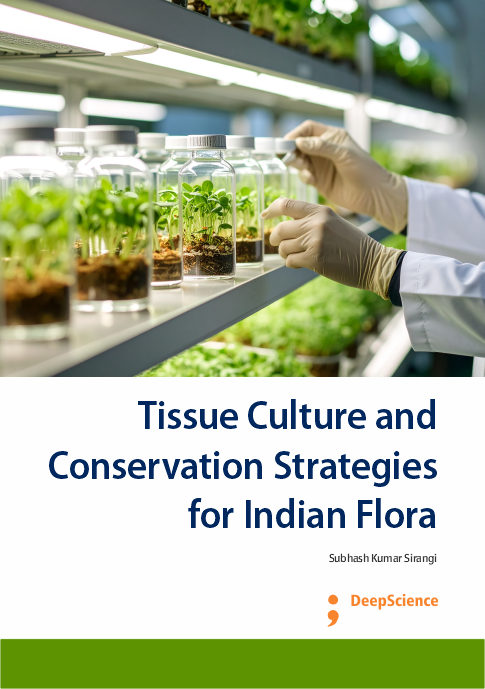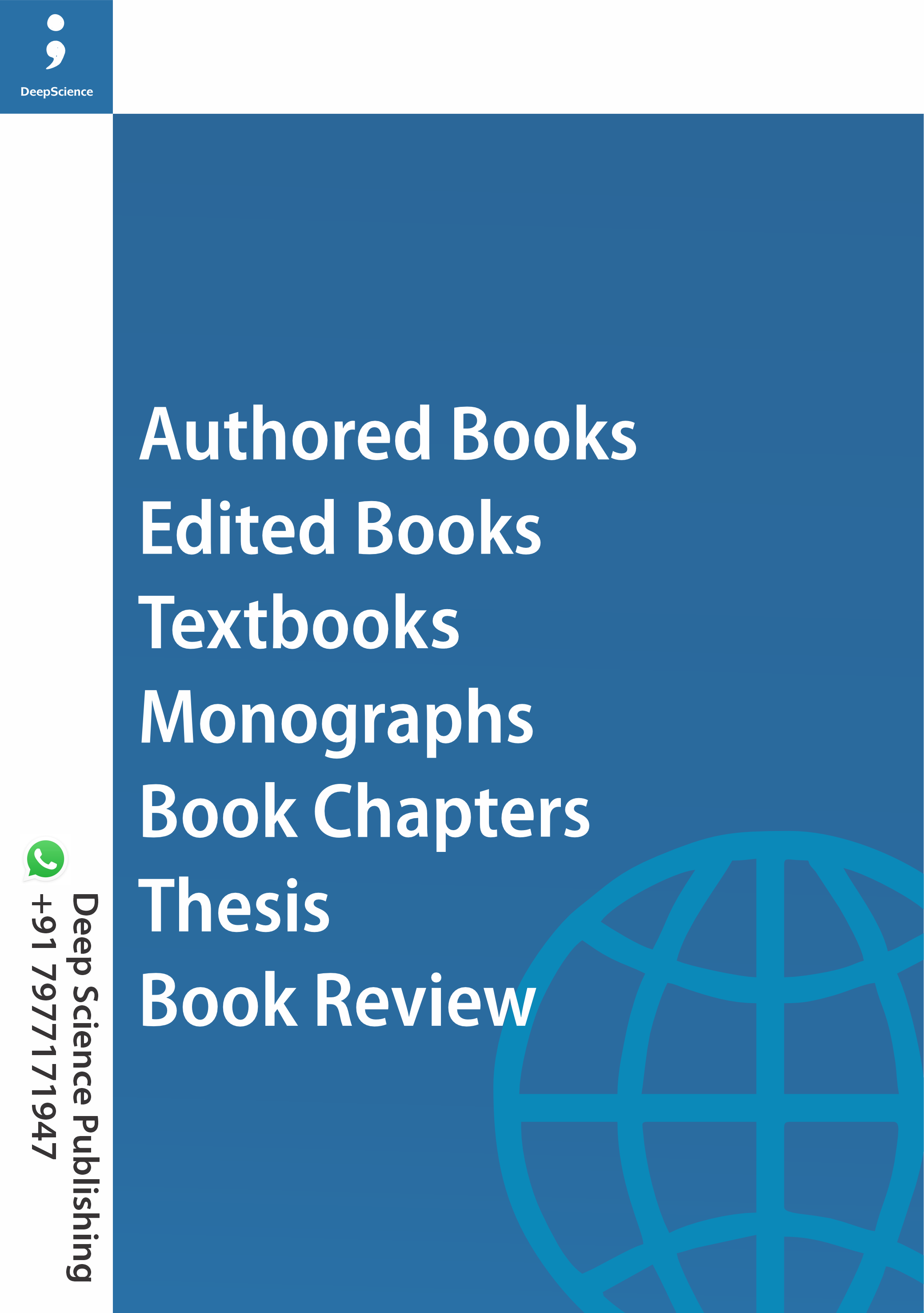Tissue Culture and Conservation Strategies for Indian Flora
Keywords:
Plant Tissue Culture, Micropropagation, Somatic Embryogenesis, Cryopreservation, Medicinal Plants, Germplasm Conservation, In Vitro PropagationSynopsis
India is globally celebrated for its remarkable floral wealth, which spans a vast range of climatic zones, ecosystems, and biogeographic regions—from the snow-clad Himalayas and arid deserts to the tropical Western Ghats and dense forest ecosystems of the Northeast. This botanical treasure includes an impressive array of endemic, medicinal, aromatic, and economically valuable plant species, many of which are now increasingly endangered due to anthropogenic pressures.
In recent decades, the escalating impacts of urbanization, industrialization, habitat destruction, deforestation, pollution, climate change, and unsustainable harvesting of wild plants have severely threatened the survival of many native species. This scenario demands not only immediate conservation action but also innovative approaches that go beyond conventional methods. As a plant biotechnologist and conservationist with deep-rooted concern for India’s botanical heritage, I have long envisioned the need for a holistic academic resource that addresses the immense potential of plant tissue culture in conserving threatened flora.
This book, “Tissue Culture and Conservation Strategies for Indian Flora,” is my sincere attempt to respond to that need. It aims to serve as both an informative reference and an inspiration for researchers, educators, students, environmentalists, policymakers, and all stakeholders who are dedicated to the cause of biodiversity conservation. The content is structured to be accessible to readers at various levels, from beginners in plant biotechnology to experienced scientists seeking updated methodologies and case-based insights.
Beginning with an overview of plant tissue culture including its history, core principles, laboratory infrastructure, and basic techniques the book gradually builds toward more specialized themes. Key chapters delve into micropropagation, organogenesis, somatic embryogenesis, synthetic seed technology, cryopreservation, and the creation of germplasm repositories. Each chapter is supported with relevant data, diagrams, and case studies to enhance understanding and application.
Special attention has been paid to the application of tissue culture in rescuing and propagating rare, medicinal, endemic, and critically endangered plant species of Indian origin. Through a comparative analysis of traditional conservation methods (such as seed banks, field gene banks, and botanical gardens) and biotechnological interventions, the book underscores the synergistic value of integrating modern and conventional conservation tools.
In addition, the broader relevance of plant tissue culture in agriculture and horticulture is thoroughly discussed. The role of this technique in improving crop yield, disease resistance,stress tolerance, and commercial propagation of high-value ornamental plants demonstrates its contribution not just to biodiversity conservation but also to national food security, livelihoods, and rural development.
No scholarly work is complete without acknowledging its challenges. This book critically examines technical and logistical constraints such as somaclonal variation, high operational costs, contamination risks, and the ethical considerations surrounding genetic manipulation, patenting, and equitable benefit-sharing of plant genetic resources. As we navigate an era of rapid ecological and climatic changes, it is clear that conservation is no longer a matter of choice it is a collective obligation. I firmly believe that when plant biotechnology, particularly tissue culture, is applied responsibly and collaboratively, it can form a critical pillar in the larger framework of sustainable development and biodiversity preservation.
I am deeply grateful to the many scientists, field workers, research institutions, and conservation agencies whose pioneering work has informed and inspired this book. Their dedication has not only advanced scientific knowledge but also safeguarded the future of India’s precious plant species.
I hope that this book will stimulate further interdisciplinary research, foster knowledge exchange, and encourage policy frameworks that support science-driven conservation. May it serve as a valuable guide for all those committed to the noble cause of protecting the green legacy of our nation for future generations.
References
Acquaah, G. (2009). Principles of Plant Genetics and Breeding (2nd ed.). Wiley-Blackwell.
Agronomy and Agriculture. (2021). Agronomy and Agriculture: A Review of Historical and Modern Practices. [Publisher information not available].
Ahmar, S., Gill, R. A., Jung, K. H., Faheem, A., Qasim, M. U., Mubeen, M., ... & Zhou, W. (2020). Conventional and molecular techniques from simple breeding to speed breeding in crop plants: Recent advances and future outlook. International Journal of Molecular Sciences, 21(7), 2590. https://doi.org/10.3390/ijms21072590
Al-Khayri, J. M., Jain, S. M., & Johnson, D. V. (2016). Advances in Plant Breeding Strategies. Springer.
Allard, R. W. (1961). Principles of Plant Breeding. Wiley.
Ashmore, S. E. (1997). Status report on the development and application of in vitro techniques for the conservation and use of plant genetic resources. IPGRI.
Ashraf, M., Akram, N. A., & Foolad, M. R. (2012). Marker-assisted selection in plant breeding: Current status and future perspectives. Journal of Plant Breeding and Crop Science, 4(10), 167–180.
Attree, S. M., & Fowke, L. C. (1993). Embryogeny of gymnosperms: Advances in synthetic seed technology. Plant Cell, Tissue and Organ Culture, 35(1), 1–35.
Barlass, M., & Skene, K. G. M. (1982). The use of shoot-tip grafting in vitro for the elimination of viruses from infected apple scions. Scientia Horticulturae, 17(3), 313–321.
Benson, E. E. (2008). Cryopreservation theory. In B. M. Reed (Ed.), Plant Cryopreservation: A Practical Guide (pp. 15–32). Springer.
Bharti, M., & Chimata, M. K. (2019). Time frame of cultivar development in conventional breeding. Journal of Agricultural Sciences, 11(2), 55–60.
Bonga, J. M., & Durzan, D. J. (2005). Tissue culture in forestry: Major achievements and present challenges. Springer.
Borlaug, N. E. (1983). Contributions of conventional plant breeding to food production. Science, 219(4585), 689–693. https://doi.org/10.1126/science.219.4585.689
Breseghello, F., & Coelho, A. S. G. (2013). Traditional and modern plant breeding methods with examples in rice (Oryza sativa L.). Journal of Agricultural and Food Chemistry, 61(35), 8277–8286. https://doi.org/10.1021/jf305531j
Bunn, E., Turner, S. R., Dixon, K. W., & Baskin, C. C. (2007). Seedling growth and establishment of endangered plants grown ex situ. Biological Conservation, 134(1), 119–128. https://doi.org/10.1016/j.biocon.2006.08.008
Cassells, A. C., & Curry, R. F. (2001). The impact of pathogens on plant tissue culture. Plant Cell, Tissue and Organ Culture, 64(2), 175–186.
Castañeda-Álvarez, N. P., Khoury, C. K., Achicanoy, H. A., et al. (2016). Global conservation priorities for crop wild relatives. Nature Plants, 2(4), 16022. https://doi.org/10.1038/nplants.2016.22
CBD (Convention on Biological Diversity). (2011). Nagoya Protocol on Access and Benefit-sharing. Secretariat of the Convention on Biological Diversity, Montreal. https://www.cbd.
Collard, B. C. Y., & Mackill, D. J. (2008). Marker-assisted selection: An approach for precision plant breeding in the twenty-first century. Philosophical Transactions of the Royal Society B: Biological Sciences, 363(1491), 557–572.
Crossa, J., Pérez-Rodríguez, P., Cuevas, J., Montesinos-López, O., Jarquín, D., de Los Campos, G., ... & Hickey, J. M. (2017). Genomic selection in plant breeding: methods, models, and perspectives. Trends in Plant Science, 22(11), 961–975.
Das, B., Sengupta, S., Prasad, M., & Roy, B. (2017). Role of DNA markers in plant breeding. Plant Biotechnology Journal, 15(4), 447–456.
Debnath, S. C. (2005). Strategies for the micropropagation of woody plants. In Vitro Cellular & Developmental Biology - Plant, 41(5), 543–554. https://doi.org/10.1079/IVP2005689
Debnath, S. C., et al. (2006). Micropropagation of ornamental plants: Recent advances and future perspectives. Biotechnology Advances, 24(4), 334–356.
Dirzo, R., Mendoza, E., & Ortíz, P. (2003). Effects of land use and plant diversity on the conservation of plant resources. Annual Review of Ecology, Evolution, and Systematics, 34, 617–643. https://doi.org/10.1146/annurev.ecolsys.34.011802.132412
Dutfield, G. (2011). Intellectual Property Rights and the Life Science Industries: A Twentieth Century History. Ashgate Publishing.
Dwivedi, S. L., Britt, A. B., Tripathi, L., Sharma, S., Upadhyaya, H. D., & Ortiz, R. (2015). Haploids: constraints and opportunities in plant breeding. Biotechnology Advances, 33(6), 812–829.
Engelmann, F. (2011). Use of biotechnologies for the conservation of plant biodiversity. In Vitro Cellular & Developmental Biology - Plant, 47(1), 5–16.
Engelmann, F. (2011). Use of biotechnologies for the conservation of plant biodiversity. In Vitro Cellular & Developmental Biology - Plant, 47(1), 5–16. https://doi.org/10.1007/s11627-010-9327-3
Engelmann, F. (2011). Use of biotechnologies for the conservation of plant biodiversity. In Vitro Cellular & Developmental Biology - Plant, 47(1), 5–16. https://doi.org/10.1007/s11627-010-9327-2
Engelmann, F. (2011). Use of biotechnologies for the conservation of plant biodiversity. In Vitro Cellular & Developmental Biology - Plant, 47(1), 5–16. https://doi.org/10.1007/s11627-010-9327-3
Ewing, W., Ferrer, M., & Lobo, D. (2019). Enhancing performance stability in crop cultivars. Field Crops Research, 241, 107570.
Falk, D. A. (2013). Restoring species and ecosystems: The need for a paradigm shift in ecological restoration. Ecological Management & Restoration, 14(3), 189-193. https://doi.org/10.1111/emr. 12056
FAO. (2010). The Second Report on the State of the World's Plant Genetic Resources for Food and Agriculture. Food and Agriculture Organization of the United Nations, Rome.
Fehr, W. R. (1987). Principles of Cultivar Development: Theory and Technique (Vol. 1). Macmillan Publishing Company.
Finlay, K. W., & Wilkinson, G. N. (1963). The analysis of adaptation in a plant breeding programme. Australian Journal of Agricultural Research, 14(6), 742–754.
Fu, Y. B. (2015). Understanding crop genetic diversity under modern plant breeding. Theoretical and Applied Genetics, 128, 2131–2142.
Gelvin, S. B. (2003). Agrobacterium-mediated plant transformation: the biology behind the "gene-jockeying" tool. Microbiology and Molecular Biology Reviews, 67(1), 16–37.
George, E. F., Hall, M. A., & De Klerk, G. J. (2008). Plant Propagation by Tissue Culture. Springer.
Gepts, P., Famula, T. R., Bettinger, R. L., Brush, S. B., Damania, A. B., McGuire, P. E., & Qualset, C. O. (2012). Biodiversity in Agriculture: Domestication, Evolution, and Sustainability. Cambridge University Press.
Giri, A., & Narasu, M. L. (2000). Transgenic hairy roots: recent trends and applications. Biotechnology Advances, 18(1), 1–22.
Hansen, G., & Wright, M. S. (1999). Recent advances in the transformation of plants. Trends in Plant Science, 4(6), 226–231.
Hartmann, H. T., Kester, D. E., Davies, F. T., & Geneve, R. L. (2011). Plant Propagation: Principles and Practices. Prentice Hall.
Hasegawa, A., Komatsu, M., & Takeno, K. (2000). Floral induction and flowering responses in vitro in ornamental plants. Plant Biotechnology, 17(4), 319–325.
Hickey, L. T., Hafeez, A. N., Robinson, H., Jackson, S. A., Leal-Bertioli, S. C. M., Tester, M., ... & Wulff, B. B. H. (2017). Breeding crops to feed 10 billion. Nature Biotechnology, 37, 744–754. https://doi.org/10.1038/s41587-019-0152-9
Huang, X., Feng, Q., Qian, Q., Zhao, Q., Wang, L., Wang, A., ... & Han, B. (2007). High-throughput genotyping and phenotyping of rice reveals key insights into domestication. Nature Genetics, 39(5), 761–765.
Irish Lorraine, B., Vardhan, A., Sharma, R., & Agarwal, P. (2019). High-throughput phenotyping tools for screening drought tolerance in crop plants. Plant Physiology Reports, 24(4), 620–632.
Jangra, R., Yadav, R., Singh, N., & Chhuneja, P. (2021). High-throughput phenotyping in cereals: Current status and future perspectives. Frontiers in Plant Science, 12, 654823.
Jiang, G. (2013). Challenges and opportunities in modern plant breeding. Breeding Science, 63(1), 1–3.
Jiang, G. L., Xu, Y., & Zeng, D. (2013). Molecular marker-assisted selection in crop improvement. In Advances in Plant Breeding Strategies (pp. 45–76). Springer.
Jonathan, R., Smith, D., & Wilson, A. (2011). Meeting global food needs through sustainable crop improvement. Global Food Security, 2(4), 234–242. https://doi.org/10.1016 /j.gfs.2011.07.005
Khoury, C. K., Bjorkman, A. D., Dempewolf, H., et al. (2014). Increasing homogeneity in global food supplies and the implications for food security. Proceedings of the National Academy of Sciences, 111(11), 4001–4006. https://doi.org/10.1073/pnas.1313490111
Larkin, P. J., & Scowcroft, W. R. (1981). Somaclonal variation—a novel source of variability from cell cultures for plant improvement. Theoretical and Applied Genetics, 60(4), 197–214.
Lee, S. H., Choi, B. S., Kim, R. W., Oh, C. S., & Kim, N. S. (2015). Recent advances and future perspectives in plant breeding. Plant Breeding and Biotechnology, 3(3), 179–191. https://doi.org/10.9787/PBB.2015.3.3.179
Lee, Y. I., Lee, N., Yeung, E. C., & Chung, M. C. (2006). Embryo development and precocious flowering in orchid cultures: A review. In Vitro Cellular & Developmental Biology - Plant, 42(5), 485–490.
Lema, M. A. (2018). Genotype-by-environment interaction in crop breeding. African Journal of Plant Science, 12(6), 121–130.
Li, L., Zhang, Q., & Huang, D. (2014). A review of imaging techniques for plant phenotyping. Sensors, 14(11), 20078–20111.
Madhusudhana, R. (2019). Molecular tools for improving crop resistance to biotic stress. Indian Journal of Genetics and Plant Breeding, 79(1), 1–9.
Maxted, N., Dulloo, M. E., Ford-Lloyd, B. V., et al. (2012). Agrobiodiversity Conservation: Securing the Diversity of Crop Wild Relatives and Landraces. CAB International.
Meyer, R. S., & Purugganan, M. D. (2013). Evolution of crop species: Genetics of domestication and diversification. Nature Reviews Genetics, 14, 840–852. https://doi.org/10.1038/nrg3605
Meyer, R. S., DuVal, A. E., & Jensen, H. R. (2012). Patterns and processes in crop domestication: An historical review and quantitative analysis of 203 global food crops. New Phytologist, 196(1), 29–48. https://doi.org/10.1111/j.1469-8137.2012.04253.x
Mir, R.R., Reynolds, M., Pinto, F., Khan, M.A., & Bhat, M.A. (2019). High-throughput phenotyping for crop improvement in the genomics era. Plant Science, 282, 60–72.
Moreira, F.F., Oliveira, H.R., Volenec, J.J., Rainey, K.M., & Brito, L.F. (2020). Integrating high-throughput phenotyping and statistical modeling to estimate phenotypic variation in soybean. G3: Genes, Genomes, Genetics, 10(3), 1015–1026.
Murashige, T., & Skoog, F. (1962). A revised medium for rapid growth and bioassays with tobacco tissue cultures. Physiologia Plantarum, 15(3), 473–497.
Nap, J. P., Metz, P. L., Escaler, M., & Conner, A. J. (2003). The release of genetically modified crops into the environment: Part I. Overview of ecological risk assessment. The Plant Journal, 33(1), 1–18.
Navarro, L., et al. (1999). Citrus germplasm sanitation, exchange, and conservation. FAO Plant Production and Protection Paper, 154, 37–47.
Navarro, L., Roistacher, C. N., & Murashige, T. (1999). Micrografting in vitro for the elimination of viruses and other pathogens from citrus. Plant Pathology, 35(5), 616–624.
Nogoy, F. M. D., Morales, R. G. E., & Lalusin, A. G. (2016). Application of molecular markers in plant breeding. International Journal of Agriculture Innovations and Research, 5(2), 2319–1473.
Paek, K. Y., Hahn, E. J., & Son, S. H. (2005). Application of bioreactors for large-scale micropropagation systems of plants. Plant Cell, Tissue and Organ Culture, 81(3), 287–300.
Pandey, D. N., & Sharma, G. (2016). Traditional knowledge for the conservation of biodiversity in India. Indian Journal of Traditional Knowledge, 15(4), 537-545.
Pasala, R., & Pandey, B. (2020). Role of high-throughput phenotyping in crop improvement. Current Trends in Plant Science, 2(1), 24–31.
Pence, V. C. (2011). Evaluating costs for the in vitro propagation and preservation of endangered plants. In Vitro Cellular & Developmental Biology - Plant, 47(1), 176–187. https://doi.org/10.1007/s11627-010-9323-7
Plant Cell Technology. (2022, June 3). Tissue Culture vs Conventional Techniques of Growing Plants. Retrieved from: https://plantcelltechnology.com
Pritchard, H. W., Wood, C. B., & Hodges, S. (2004). Cryopreservation of desiccation-sensitive seeds. In F. Engelmann (Ed.), Cryopreservation of Tropical Plant Germplasm: Current Research Progress and Application (pp. 161–172). IPGRI.
Purohit, S. D., & Kukda, G. (2018). Tissue culture technology: A commercialization perspective. Plant Biotechnology Perspectives, 4, 55-72.
Purohit, S. D., & Kukda, G. (2018). Tissue culture technology: A commercialization perspective. Plant Biotechnology Perspectives, 4, 55-72.
Rabier, C. E., Barre, P., Asp, T., Charmet, G., & Hospital, F. (2016). On the accuracy of genomic selection. Genetics, 203(1), 373–383.
Rai, M., Shekhawat, M. S., & Kataria, V. (2011). Somatic hybridization and protoplast culture: A biotechnological approach for crop improvement. Plant Tissue Culture & Biotechnology, 21(1), 1-8.
Rai, M., Shekhawat, M. S., & Kataria, V. (2011). Somatic hybridization and protoplast culture: A biotechnological approach for crop improvement. Plant Tissue Culture & Biotechnology, 21(1), 1-8.
Ramachandra Rao, S., & Ravishankar, G. A. (2002). Plant cell cultures: chemical factories of secondary metabolites. Biotechnology Advances, 20(2), 101–153.
Ramage, C. M., & Williams, R. R. (2002). Mineral nutrition and plant morphogenesis in tissue culture. Plant Cell, Tissue and Organ Culture, 72(2), 103–110.
Rao, N. K., Hanson, J., Dulloo, M. E., Ghosh, K., Nowell, D., & Larinde, M. (2006). Manual of seed handling in genebanks. Bioversity International.
Raza, G., et al. (2018). Application of plant tissue culture in agriculture: Current trends and prospects. Biotechnology Reports, 18, e00266.
Rebetzke, G.J., Jimenez-Berni, J.A., Fischer, R.A., Deery, D.M., & Smith, D.J. (2018). Review: High-throughput phenotyping to enhance the use of crop genetic resources. Plant Science, 282, 40–48.
Redenbaugh, K., Fujii, J., Slade, D., & Colwell, R. (1991). Synthetic seeds: Engineering of plant propagation. Bio/Technology, 9, 835–843.
Reed, B. M. (2008). Plant cryopreservation: A practical guide. Springer Science & Business Media.
Reed, B. M. (2008). Plant cryopreservation: A practical guide. Springer Science & Business Media.
Reed, B. M., et al. (2021). Plant cryopreservation: A practical guide. Springer.
Reed, B. M., Sarasan, V., Kane, M., Bunn, E., & Pence, V. C. (2011). Biodiversity conservation and conservation biotechnology tools. In Vitro Cellular & Developmental Biology - Plant, 47(1), 1–4. https://doi.org/10.1007/s11627-011-9356-3
Reuther, W., Calavan, E. C., & Nauer, E. M. (1990). Elimination of tristeza and exocortis viruses from citrus by shoot-tip grafting. Proceedings of the International Organization of Citrus Virologists, 11, 27–32.
Ricroch, A., Berge, J. B., & Kuntz, M. (2014). Advantages of modern biotechnology for food security and climate change. Plant Cell Reports, 33, 641–650.
Robertsen, C. D., Momen, M., & Kadarmideen, H. N. (2019). Genomic selection in crop improvement: methods, applications and perspectives. Plant Science Today, 6(1), 6–19.
Rout, G. R., Samantaray, S., & Das, P. (2006). Biotechnology of the medicinal plants: Conservation and sustainable utilization. In Vitro Cellular & Developmental Biology - Plant, 42(3), 206-217. https://doi.org/10.1079/IVP2006767
Rout, G. R., Samantaray, S., & Das, P. (2006). Biotechnology of the medicinal plants: Conservation and sustainable utilization. In Vitro Cellular & Developmental Biology - Plant, 42(3), 206-217. https://doi.org/10.1079/IVP2006767
Sarasan, V., Cripps, R., Ramsay, M. M., Atherton, C., McMichen, M., Prendergast, G., & Rowntree, J. K. (2006). Conservation in vitro of threatened plants—progress in the past decade. In Vitro Cellular & Developmental Biology - Plant, 42(3), 206–214. https://doi.org/10.1079/IVP2006769
Sarasan, V., et al. (2006). Conservation of rare, endangered and threatened plants through tissue culture: perspectives and protocols. Plant Cell, Tissue and Organ Culture, 87(1), 1–20.
Sharma, S., Shahzad, B., Rehman, A., Bhardwaj, R., & Landi, M. (2020). Tissue culture-based conservation of endangered plant species. Plants, 9(4), 563. https://doi.org/10.3390/ plants9040563.
Shu, Q. Y., & Wu, J. L. (2016). Trait-specific marker-assisted selection in rice improvement. Molecular Plant Breeding, 7(2), 50–58.
Sweeney, D. W., Zhao, Y., & Xu, S. (2019). Genomic selection for crop improvement: advances and prospects. Theoretical and Applied Genetics, 132(1), 1–20.
Thorpe, T. A. (2007). History of plant tissue culture. Molecular Biotechnology, 37(2), 169–180.
Thorpe, T. A. (2007). History of plant tissue culture. Molecular Biotechnology, 37(2), 169–180.
Wang, X., Xu, Y., Hu, Z., & Xu, C. (2018). Genomic selection methods for crop improvement: current status and prospects. The Crop Journal, 6(4), 330–340.
Zhang, X., & Zhang, Q. (2018). Chlorophyll fluorescence imaging for plant stress detection. Journal of Agricultural Engineering, 6(2), 35–42.
Zohary, D., Hopf, M., & Weiss, E. (2021). Domestication of Plants in the Old World (5th ed.). Oxford University Press.














